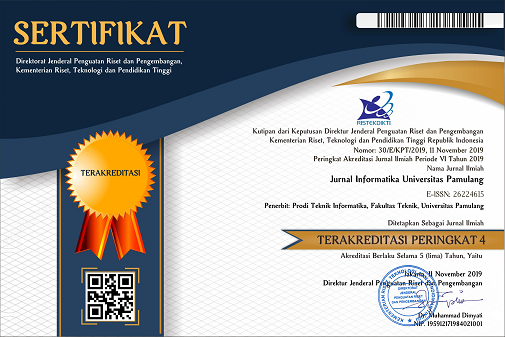Perbandingan Metode KNN, Decision Tree, dan Naïve Bayes Terhadap Analisis Sentimen Pengguna Layanan BPJS
DOI:
https://doi.org/10.32493/informatika.v5i4.7622Keywords:
Sentiment Analysis, BPJS, Twitter, Data MiningAbstract
BPJS is really helpful because one of its goal is to provide good service for the member in terms of healthiness. But, when there’s many people using the service, then it will cause more pros and contras. Therefore, researcher will be doing sentiment analysis in the field of data mining towards bpjs users on social media Twitter as much as 1000 data that later will be filtered to be 903 data because there are some data that has been duplicated. Researchers used the KNN, Decision Tree, and Naïve Bayes methods to compare the accuracy of the three methods. Researchers used the RapidMiner version 9.7.2 tools. The results showed that the sentiment analysis of Twitter data on BPJS services using the KNN method reached an accuracy level of 95.58% with class precision for pred. negative is 45.00%, pred. positive is 0.00%, and pred. neutral is 96.83%. Then the Decision Tree method the accuracy rate reaches 96.13% with the precision class for pred. negative is 55.00%, pred. positive is 0.00%, and pred. neutral is 97.28%. And the last one is the Naïve Bayes method which achieves 89.14% accuracy with precision class for pred. negative is 16.67%, pred. positive was 1.64%, and pred. neutral is 98.40%.References
Buntoro, G. A. (2017). Analisis Sentimen Calon Gubernur DKI Jakarta 2017 di Twitter. Journal of Information Technology, 1(1), 32–41.
Cahyaningrum, N. I., Fatima, D. W. Y., Kusuma, W. A., Ramadhani, S. A., Destanto, M. R., & Nooraeni, R. (2020). Analysis of User Sentiment of Twitter to Draft KUHP. Jurnal Matematika, Statistika Dan Komputasi, 16(3), 273. https://doi.org/10.20956/jmsk.v16i3.8239
Cahyanti, D., Rahmayani, A., & Ainy, S. (2020). Analisis Performa Metode KNN Pada Dataset Pasien Pengidap Kanker Payudara. 1(2), 39–43.
Fitriyyah, S. N. J., Safriadi, N., & Pratama, E. E. (2019). Analisis Sentimen Calon Presiden Indonesia 2019 dari Media Sosial Twitter Menggunakan Metode Naive Bayes. Jurnal Edukasi Dan Penelitian Informatika (JEPIN), 5(3), 279. https://doi.org/10.26418/jp.v5i3.34368
Linda, L., Haskas, Y., & Kadrianti, E. (2020). Perbedaan Persepsi Pengguna Jasa BPJS Dan Non BPJS (Umum) Tentang Kualitas Pelayanan Keperawatan Dirsud Timika-Papua. 15.
Nurdin, A. D. (2017). Penerapan Data Mining Untuk Menganalisis Penjualan Barang Dengan Menggunakan Metode Apriori Pada Supermarket Sejahtera Lhokseumawe. Astika, D., Studi, P., Informatika, T., & Malikussaleh, U., Vol. 6 No.
Sari, R. (2020). Analisis Sentimen Pada Review Objek Wisata Dunia Fantasi Menggunakan Algoritma K-Nearest Neighbor (K-Nn). EVOLUSI?: Jurnal Sains Dan Manajemen, 8(1), 10–17. https://doi.org/10.31294/evolusi.v8i1.7371
Sarimuddin, S., Sari, J. Y., Mail, M., Masalu, M. A., Aristika, R. S., & Nurfagra, N. (2020). Klasifikasi Data Aging Tunggakan Nasabah Menggunakan Metode Decision Tree Pada ULaMM Unit Kolaka. INFORMAL: Informatics Journal, 5(1), 26. https://doi.org/10.19184/isj.v5i1.16964
Sinaga, L. M., Sawaluddin, & Suwilo, S. (2020). Analysis of classification and Naïve Bayes algorithm k-nearest neighbor in data mining. IOP Conference Series: Materials Science and Engineering, 725(1). https://doi.org/10.1088/1757-899X/725/1/012106
Utami, I. (2020). Analisis Sistem Informasi Banjir Berbasis Media Twitter. 9(1), 67–72.
Zhang, W., Chen, X., Liu, Y., & Xi, Q. (2020). A Distributed Storage and Computation k-Nearest Neighbor Algorithm Based Cloud-Edge Computing for Cyber-Physical-Social Systems. IEEE Access, 8, 50118–50130. https://doi.org/10.1109/ACCESS.2020.2974764
Downloads
Published
Issue
Section
License
Authors who publish with this journal agree to the following terms:
- Authors retain copyright and grant the journal right of first publication with the work simultaneously licensed under a Creative Commons Attribution-NonCommercial 4.0 International (CC BY-NC 4.0) that allows others to share the work with an acknowledgement of the work's authorship and initial publication in this journal.
- Authors are able to enter into separate, additional contractual arrangements for the non-exclusive distribution of the journal's published version of the work (e.g., post it to an institutional repository or publish it in a book), with an acknowledgement of its initial publication in this journal.
- Authors are permitted and encouraged to post their work online (e.g., in institutional repositories or on their website) prior to and during the submission process, as it can lead to productive exchanges, as well as earlier and greater citation of published work (See The Effect of Open Access).
Jurnal Informatika Universitas Pamulang have CC-BY-NC or an equivalent license as the optimal license for the publication, distribution, use, and reuse of scholarly work.
In developing strategy and setting priorities, Jurnal Informatika Universitas Pamulang recognize that free access is better than priced access, libre access is better than free access, and libre under CC-BY-NC or the equivalent is better than libre under more restrictive open licenses. We should achieve what we can when we can. We should not delay achieving free in order to achieve libre, and we should not stop with free when we can achieve libre.
Jurnal Informatika Universitas Pamulang is licensed under a Creative Commons Attribution-NonCommercial 4.0 International (CC BY-NC 4.0)
YOU ARE FREE TO:
- Share : copy and redistribute the material in any medium or format
- Adapt : remix, transform, and build upon the material for any purpose, even commercially.
- The licensor cannot revoke these freedoms as long as you follow the license terms





